This post covers conducting a content audit, addressing SERP (search engine results page) changes, and targeting secondary keywords to increase conversions. We also use real client graphs to show you performance and metrics but removed all client-sensitive information from this post. When it comes to detailing how to find and rank for secondary keywords, we will use our blog as an example.
At Grow and Convert, we generate conversions (not just traffic and rankings) for clients by writing original, interview-backed blog content optimized to rank for high buying-intent keywords.
Every blog post we write for a client is written to rank for a specific keyword, and it’s written with the intention that it will convert. What counts as a conversion varies from client to client, but it’s generally signing up for a free trial or scheduling a demo.
This strategy has been incredibly effective for clients across all types of industries, including:
- A no-code software testing platform
- A post-concussion treatment center
- A self-service B2B SaaS company
Because we’re hyper-focused on bringing in conversions for our clients, we know when a blog post starts to falter or plateau (i.e., converting less than it once did or not continuing to grow as expected).
This happened last year with a SaaS client.
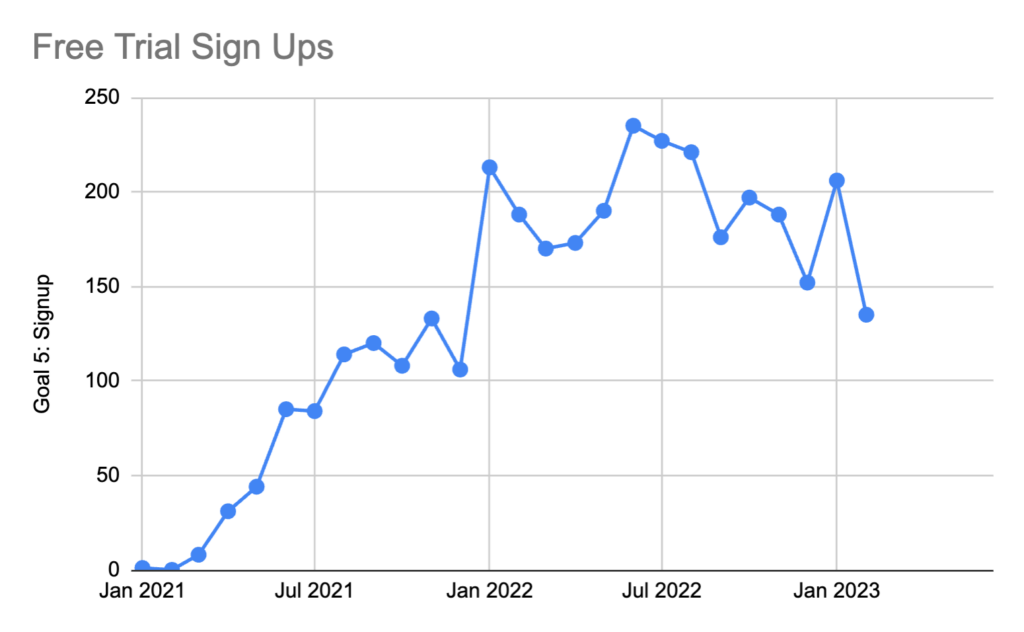
The number of free trial signups directly attributable to our content for this client was growing steadily before plateauing in 2022 and then dipping in late 2022 and early 2023 (see how we attribute conversion events to specific pages in GA4 here).
What was the problem? And how did we turn it around?
It turns out there were multiple factors in play (including Google algorithm updates), but, in our analysis, we also discovered the massive importance of secondary keywords. Secondary keywords are keywords that our posts happen to rank for but aren’t the main target keyword that we optimize the post for.
In the case of this client, we noticed that these secondary keywords, which were similar in intent to the primary keyword, often brought in more traffic than the primary keyword — sometimes significantly more.
For example, “accounting app for small business” gets 390 searches a month, but many posts ranking for it also rank for “small business accounting software,” which gets 9900 searches per month. That’s an extreme example, but it’s illustrative of the impact secondary keywords can have. We had countless posts that were doing exactly this for our client. What’s also pertinent about this example is that the search intent of these two keywords is similar: both indicate someone is looking to buy accounting software.
So, if you rank for secondary keywords like this, those “serendipitous” or “unintentional” rankings will also bring in conversions for you. Inversely, if you lose this ranking, you’ll see a dip in conversions from that article.
And that’s what happened with a few key articles for our client. The SERPs changed over time, and our content started losing its top positions for secondary keywords. Finding those secondary keywords allowed us to implement strategies to reclaim those lost rankings, which ultimately increased conversions for our client.
That’s what this post is about, and we break it down into these three sections:
- Conducting a content audit to find opportunities
- Locating high-value secondary keywords that were lost due to SERP changes
- Developing a strategy to re-rank for those lost secondary keywords
1. Conducting a Content Audit
We had published original blog posts for this specific client for ~2 years, which meant we had published ~71 posts — all of which were designed to rank for high buying-intent keywords.
As per our Pain Point SEO strategy, we targeted category keywords, comparison keywords, jobs-to-be-done keywords, and deviant keywords. We discovered keywords in each of those buckets by first interviewing the client to learn what specific pain points they solve for their customers and then finding keywords that correspond to those pain points.
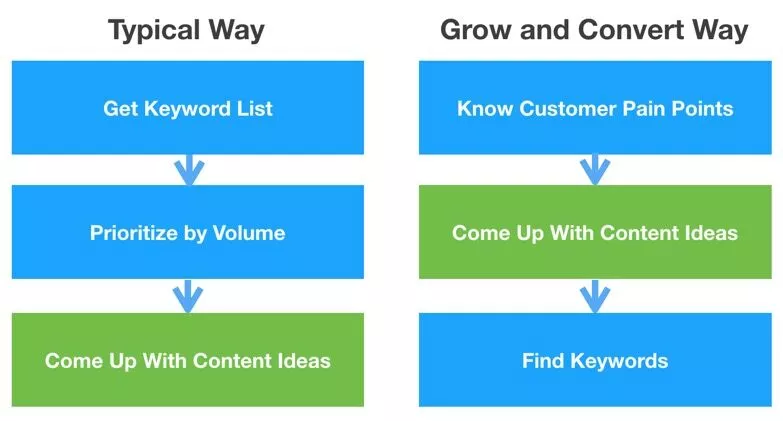
And the results were strong.
- By the first 6 months, our content had converted 168 times.
- By the first 12 months, our content had converted 848 times.
- 18 months into the engagement, our content had brought in 2,059 conversions.
Plus, our client was seeing a significant ROI based on their internal data of how many free trials were converted to paid customers and the average lifetime value of one customer.
But, as discussed in the intro, a plateau in new free trial sign-ups occurred, followed by a dip. The growth we saw in the first year of engagement wasn’t happening (that we could see) in the second year.
When we noticed this stagnation and degradation, we did a high-level content audit. We looked closely at how each article was converting to try and spot opportunities for improvement.
After conducting the audit, we saw two things.
First, plenty of our posts were still converting well. 31 out of 60 published posts were converting consistently (and bringing in at least one conversion a month). A quick note: Blog articles take time to rank, so we excluded 3 months’ worth of published posts from this tally as those posts are too new to consider in the round-up of “Is this post ranking and converting?”.
But we also noticed some posts that either a) weren’t performing as well as they once did, or b) hadn’t performed well comparatively. We grouped these posts into 4 different categories:
- Historically high-converting posts that had dropped out of the top 3 spots for their target keyword.
- Historically high-converting posts that were still ranking in the top 3 for their target keyword yet saw a significant dip in conversions.
- Historically low-converting posts that were (and had always been) in the top 3 for their target keyword.
- Low-converting / non-converting posts that had never consistently ranked for their target keyword.
Once we had those broad categories, the next step was developing strategies to increase conversions and continue to deliver growth to our client.
Narrowing Our Scope (to See as Much Growth as Possible, as Soon as Possible)
Since our goal was to reverse the conversion dip as fast as possible, we decided to focus on these two categories of posts first:
- Historically high-converting posts that had dropped out of the top 3 spots for their target keyword.
- Historically high-converting posts that were still ranking in the top 3 for their target keyword yet saw a significant dip in conversions.
These posts had, at some point, brought in a lot of conversions, so we just had to get them to do that again.
In contrast, the category “historically low-converting posts that always ranked in the top 3 for its target keyword” involved posts that never brought in a lot of conversions despite ranking well. We noticed that those posts just got less traffic and, thus, fewer conversions. So while their conversion rates were on par with the rest of our content, they were always just going to bring in fewer conversions for the client. And, while there are strategies to improve those types of low-converting posts, the immediate effect would be too small to make a significant difference in growth.
Similarly, “low-converting / non-converting posts that had never consistently ranked for their target keyword” would take longer to see growth and conversions because you have to wait to get rankings you hadn’t had before. Therefore, we marked these as low-priority posts that we’d take a closer look at after we first maximized growth by targeting the two types of historically high-converting posts.
Developing the Appropriate Strategy (on a per Article Basis)
Once we had a list of posts to focus on, we thought of two immediate tactics to reclaim lost secondary keyword rankings and increase conversions again.
Tactic 1: Increase Link-Building Efforts
As part of our normal service, we build links for clients to help our content rank faster. We have a certain number of articles and links that we create on behalf of the client every month, but the challenge on the link-building side is that some articles require more links than others. So we don’t distribute links evenly.
As the engagement goes on, we shift priorities from building links to recently published pieces to focus more on building links to the pieces we know convert well.
After doing the audit, we felt there was an opportunity to build more links to some of the pieces that had recently slipped in rankings.
We were more likely to choose this strategy if:
- The post in question didn’t have a lot of backlinks built to it.
- The post was ranking in position 3-5 for the target keyword.
- The SERP for the target keyword has not changed significantly since the post was published (more on this below).
Tactic 2: Re-optimize Past Content
When we write content for a client, we use two sources of information that help inform our post:
- The client-specific information that we get during interviews with them. It’s this information that lets us do productive and intentional keyword research, where we find keywords tied to real pain points that the client’s customer is actively trying to solve. It’s precisely what gets our content to bring in high buying-intent traffic that generates leads and new customers.
- The existing SERP for the keyword. Our posts must rank high for their target keyword to have a chance at converting — that means we must have a case for how our content will rank in the SERP.
But SERPs change over time. New content gets published by the competition. Interpretations and meanings of search terms shift and evolve. Google updates its algorithm. So we considered it might be the case that some of our previously published content might need to be “re-optimized” to be able to compete within the new SERP landscape.
Here’s a hypothetical example of SERP changes that should help illustrate our point.
Example 1: Changing Target Customer
Let’s say we wrote a blog post targeting the keyword “vacation tracker,” and at that time, the SERP was full of posts about vacation tracking software for companies, i.e., software that helps companies track their team’s vacations. But let’s say as time went on, the SERP began to change into a different use-case: individuals tracking their own personal vacation.
In that case, we’d need to take the original content we wrote for “vacation tracker” and re-optimize it towards a more suitable keyword.
Example 2: Changing Solution Types
Here’s another hypothetical showing a different (but also common) way that SERPs can change: let’s say we wrote a post for “employee onboarding systems,” and when we wrote the post, the SERP was full of listicles and how-to guides showing small businesses how to onboard new employees using ad hoc tools like spreadsheets to build their own “system” — a keyword in that search query.
But, say that over time, more HR SaaS solutions emerged with dedicated software for employee onboarding. It’s quite possible, in that case, that the SERP would change, and some of these “how to build an onboarding system with spreadsheets” posts would get replaced by sites from these dedicated onboarding SaaS tools. It’s also likely that the search engine would no longer differentiate between “system” and “software,” and the SERP for “employee onboarding system” would have a lot of overlap with “employee onboarding software”. We’ve seen shifts like this many times.
In this case, again, our old content would need to be updated and re-optimized to the new SERP landscape.
We were more likely to choose this “re-optimization” strategy if:
- The post was ranking in position 6 or lower for its target keyword.
- The SERP had changed significantly since our piece was published.
- The post’s Clearscope score has gone down.
A quick note: We use Clearscope, a content optimization tool, to help give our blog posts an even greater competitive edge within search engine results. While a piece’s Clearscope score is not the ultimate deciding metric in whether or not a piece will rank, we’ve found that it helps. There are other content optimization tools you can use, but we really like Clearscope and prefer it. Full disclosure: They are also a client, although we had been using the tool long before working with them.
It was in the process of assigning one of these strategies to each post that we discovered secondary keywords and their potential impact on conversions, which is what we discuss below.
2. Finding Secondary Keywords with High Buying-Intent
When we took a deeper look at historically high-converting blog content that was still ranking in the top spots for its target keyword yet had seen a drop in conversions, we noticed something that we started calling “secondary keywords”. Secondary keywords are keywords that our blog posts had ranked for indirectly. As discussed in the intro, these secondary keywords were often semantically similar or related to our primary keyword. Here’s an example using a blog post from our own blog.
We wrote this post, How to Create a SaaS Content Strategy That Drives Signups, to rank for the target keyword “saas content strategy.”
At the time of writing this post, that post ranks for its target keyword in position 5. A quick note: These screenshots are pulled from Ahrefs, but many other keyword research tools like SEMRush do something similar in terms of secondary keyword analysis. Although, you’ll likely need a tool more advanced than Google Keyword Planner.

But, if we look at all of its organic keywords, we see that it ranks for around 91 other relevant keywords. Most of these keywords are semantically similar or just variations or synonyms of the main keyword. But this post receives a good percentage of its traffic from these secondary keywords.
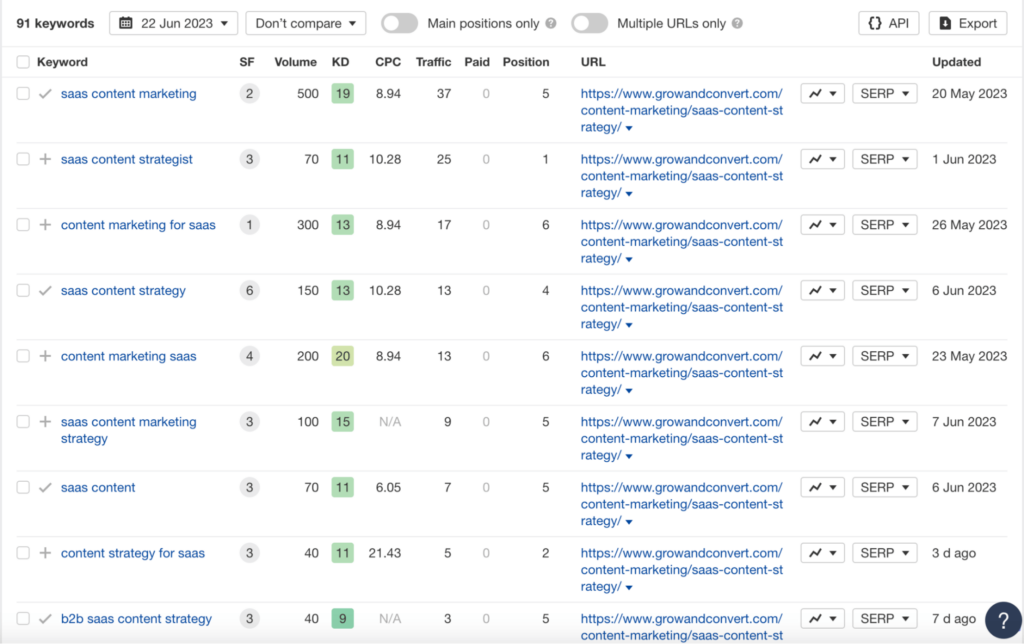
To find as many opportunities to add to our list of keywords, we can take a look at the specific post’s performance in terms of traffic. When we do that, we see that right now (as of this article’s writing), it’s at a peak in terms of traffic. But it also had a strong month in April 2023, with its highest organic traffic date being April 15th.
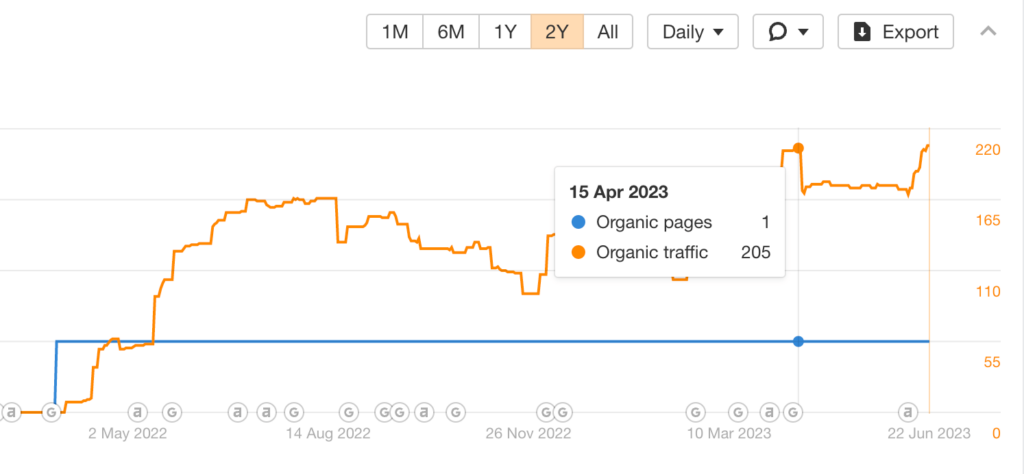
Then we can pull up all the secondary keywords this post ranked for on April 15th and compare them to those it ranked for on June 22nd (i.e., the current date at the time).
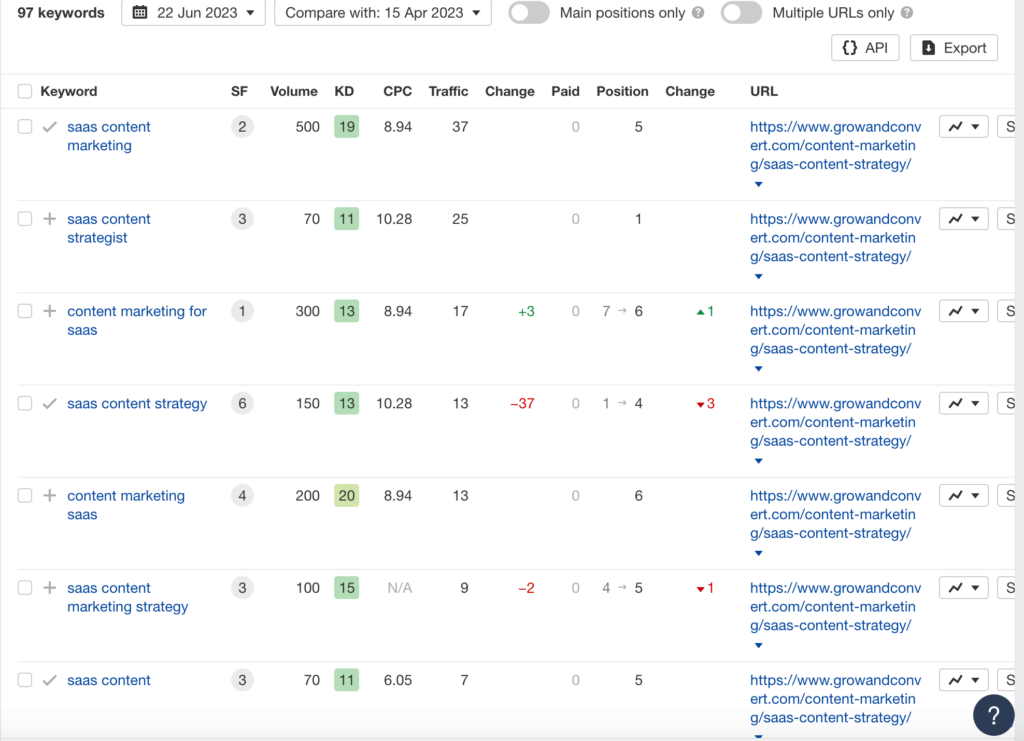
This lets us see what keywords were gained or lost in that time.
This example illustrates the crux of our process, but, when it comes to doing this type of research for our client, what we look at first is the best converting month for a specific post in the entire engagement (not the highest-trafficked month, though they’re often the same).
For example, here’s a screenshot of a waterfall chart we use to track conversions for this client. You can see that in June 2022, the highlighted post had converted 61 times, then it began to decline, getting as few as 15 conversions in December and 24 in January 2023.

To fix this problem, we pulled up what organic keywords this post was ranking for in June 2022. And then we focused on the keywords that brought in the most traffic and that had the highest buying-intent. It’s essential to keep in mind that our focus on targeting high buying-intent keywords never goes away.
Identifying high buying-intent keywords (whether they’re long tail keywords, comparison keywords, etc.) is the foundation of our content marketing strategy.
Our goal is not to increase traffic but to increase conversions (that’s why this process starts with consulting our conversion spreadsheet, not our traffic report). All other things being equal, we would pick a secondary keyword with high buying-intent and low search volume over a secondary keyword with low buying-intent and high search volume.
3. Developing a Strategy to Re-rank for Those Lost Secondary Keywords
Once we had the secondary keywords we thought were the most valuable, we saw two viable strategies:
- Write brand new content for those secondary keywords we had once ranked for but had since lost.
- Go back and re-optimize that existing post to rank for that lost secondary keyword.
Let’s look at how we decided which method to use.
Deciding When a Lost Secondary Keyword Warrants a New Article
A lost secondary keyword can be a great opportunity for a brand-new article. This is because the secondary keywords we found are of similar intent to keywords we know convert.
If the SERP has changed enough between the primary keyword and the secondary keyword, a new article may be warranted.
To figure out if this is the case, we look at the existing SERP of both the primary keyword and the lost secondary keyword. This free tool lets you do a high-level SERP comparison, but we also recommend taking a deep-dive into the SERP and looking at what the ranking articles are positioning.
Another way to find potentially new keywords to target: Secondary keywords that were never ranking in the top 10 spots could also be viable options for new articles
Deciding When a Lost Secondary Keyword’s Intent Can Be Fulfilled by an Existing Article
But, sometimes the lost secondary keyword doesn’t warrant a new article. Instead, we found the best strategy was to re-optimize the existing article to target that lost secondary keyword.
This is the case when the SERPs for the two distinct keywords are more similar than they are different or if that secondary keyword is still ranking on the first page of the SERP.
For example, let’s look back at our own blog post we referenced above.

You can see the post is ranking in position 5 for the keyword “saas content marketing” and in position 8 for “b2b saas content marketing strategy.”
So the question becomes: Does the inclusion of “b2b” and “strategy” in that secondary keyword make the SERP different enough that it warrants a brand-new post?
To answer this, we first look at a clear visual comparison of the SERPs (using the free tool we referenced above).
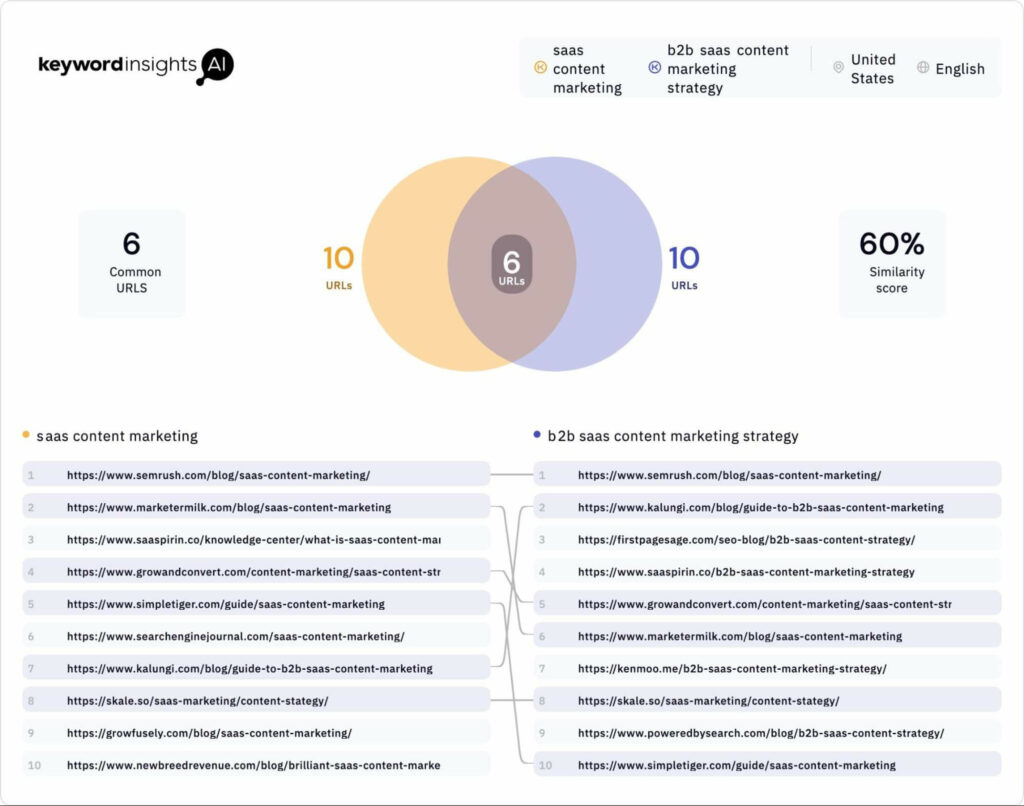
From this tool, we can see that these keywords have the same #1 post. The SERPs are also 60% similar. And, more importantly, our one post is ranking in both SERPs. Because of this, we would re-optimize our existing post to also rank for the secondary keyword “b2b saas content marketing strategy.”
What Does Re-optimizing Content Look Like?
The actual specifics of re-optimizing a blog post are too nuanced to get into here, as it changes drastically depending on the specific keyword you’re trying to rank for.
But, as a general guideline, we focus on:
- The angling and intent of the blog post. At the forefront of our minds through every edit is: does the angling/positioning match the searcher’s intent. While there will be overlap between related keywords, there are also likely some differences. We make sure the updated content is tailored towards the search intent of both the primary and secondary keywords.
- Basics of on-page SEO. We look at the title, headings, meta descriptions, and alt tags. We also check to make sure the new keyword is mentioned throughout the copy (while avoiding obvious pitfalls like keyword stuffing or flagrantly forced writing).
Results from This Process
We started doing this re-optimization process for our client in February 2023, and the results were quick and promising.
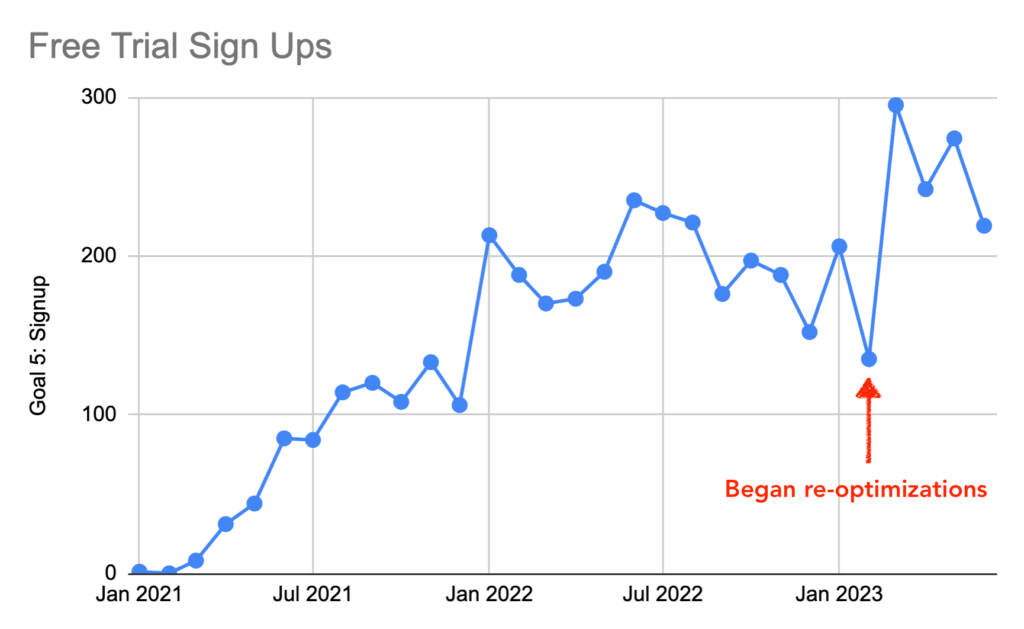
Our client saw an all-time high in free trial sign-ups, and while there were ebbs and flows in performance in the following months, conversions were now bottoming out at what was once an all-time high.
In the 4 months before we did re-optimizations, our content was averaging 171 conversions a month. In the 4 months since we started doing re-optimizations, our content has averaged 258 conversions a month.
Finally, we re-optimized 22 blog posts to re-rank for secondary keywords. We had 30 secondary keywords we were trying to re-rank for. Out of those 30, 20 of those secondary keywords saw significant improvement in ranking positions.
Liked this article? You might also enjoy:
Learn More about Our SEO and Content Marketing Agency
- Our Agency: If you want to hire us to execute a content-focused SEO strategy built around driving lead generation and sales, not just traffic, you can learn more about working with us here.
- Join Our Content Marketing Team: If you’re a content marketer or writer and would love to do content marketing in this way, we’d love to have you apply to join our team.
- Our Content Marketing Course: Individuals looking to learn our agency’s content strategy and become better marketers, consultants, or business owners can join our private course and community, taught via case studies, and presented in both written and video content formats. We include several details and examples not found on this blog. Our course is also built into a community, so people ask questions, start discussions, and share their work in the lesson pages themselves, and we, along with other members, give feedback. Learn more here.








